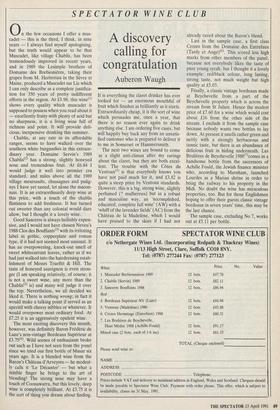SPECTATOR WINE CLUB
A discovery calling for congratulation
Auberon Waugh
0 n the few occasions I offer a mus- cadet — this is the third, I think, in nine years — I always find myself apologising, but the truth would appear to be that Muscadet, like village Chablis, has been tremendously improved in recent years, and in 1989 the Lesimple brothers of Domaine des Brebionieres, taking their grapes from M. Herbretau in the Sevre et Maine, produced a Muscadet sur Lie which I can only describe as a complete justifica- tion for 350 years of pretty indifferent efforts in the region. At £3.98, this wine.) shows every quality which muscadet is supposed to possess when you read about it — excellently fruity with plenty of acid but no sharpness, it is a living wine full of richness and point. It will provide deli- cious, inexpensive drinking this summer.
Chablis, at any rate in its affordable ranges, seems to have walked over the southern white burgundies in this extraor- dinary year. Domaine Servin's 1989 Chablis(2) has a strong, slightly honeyed nose and tremendous fruit. At £6.84 I would judge it well into premier cru standard, and miles above all the 1989 village meursaults, chassagnes and pulig- nys I have yet tasted, let alone the macon- nais. It is an extraordinarily deep wine at this price, with a touch of the chablis flintiness to add freshness. It has turned out sweeter than any colonial would dare allow, but I thought it a lovely wine.
Good Sancerre is always hellishly expen- sive, and I would not have chosen Neveu's 1988 Clos des Bouffants(3) with its irritating label in gothic, copperplate and roman type, if it had not seemed most unusual. It has an overpowering, knock-out smell of sweet whitecurrant leaves, rather as if we had just walked into the hairdressing estab- lishment of Messrs Truefitt & Hill. The taste of honeyed sauvignon is even stron- ger (I am speaking relatively, of course; it is not a sweet wine, any more than the Chablis(2) is) and many will judge it over the top. Nevertheless, we all decided we liked it. There is nothing wrong; in fact it would make a talking point if served as an aperitif with cheesy nibbles or whatever. It would overpower most ordinary food. At £7.25 it is an aggressively opulent wine.
The most exciting discovery this month, however, was definitely Baron Frederic de Luze's non-vintage Bordeaux Superieur at £3.75(0. Wild scenes of enthusiasm broke out such as I have not seen from the panel since we tried our first bottle of Musar six years ago. It is a blended wine from the Baron's Château d'Arveyres — he modest- ly calls it 'Le Decanter' — but what a nimble finger he brings to the art of blending! The strong nose may have a touch of Coonawarra, but this lovely, deep wine is completely brilliant. At £3.75 it is the sort of thing you dream about finding. It is everything the claret drinker has ever looked for — an enormous mouthful of fruit which finishes as brilliantly as it starts. Extraordinarily cheap, it is the sort of wine which persuades me, once a year, that there is no reason ever again to drink anything else. I am ordering five cases, but will happily buy back any from an unsatis- fied customer who is prepared to deliver it to me in Somerset or Hammersmith.
The next two wines are bound to come as a slight anti-climax after my ravings about the claret, but they are both excel- lent. The trouble with the Cotes du Ventoux(5) is that everybody knows you have not paid much for it, and £3.82 is quite a steep price by Ventoux standards. However, this is a big, strong wine, slightly perfumed (? mulberries) but in a robust and masculine way, an 'accomplished, educated, complete full wine' (AW) with a `whiff of the lavender fields' (AC) from the Château de la Madelene, which I would have praised to the skies if I had not already raved about the Baron's blend.
Last in the sample case, a first class Crozes from the Domaine des Entrefaux (Tardy et Ange)161. This scored less high marks from other members of the panel, because not everybody likes the taste of pure young syrah, but I thought it a lovely example: red/black colour, long lasting, strong taste, not much weight but high quality at £5.03.
Finally, a classic vintage bordeaux made at Beychevelle from a part of the Beychevelle property which is across the stream from St Julien. Hence the modest price of £7.60 for a wine which would cost about £16 from the other side of the stream. I exclude it from the sample case because nobody wants two bottles to lay down. At present it smells rather green and nettly with a strongly herbaceous and tannic taste, but there is an abundance of delicious fruit in hiding underneath. Les Brulieres de Beychevelle 1988(7)comes in a handsome bottle from the successors of Achille Fould, the Jewish finance minister who, according to Marnham, launched Lourdes as a Marian shrine in order to bring the railway to his property in the Midi. No doubt the wine has miraculous properties, too. But for those Englishmen hoping to offer their guests classic vintage bordeaux in seven years' time, this may be the last chance.
The sample case, excluding No 7, works out at £5.11 per bottle.


























































 Previous page
Previous page